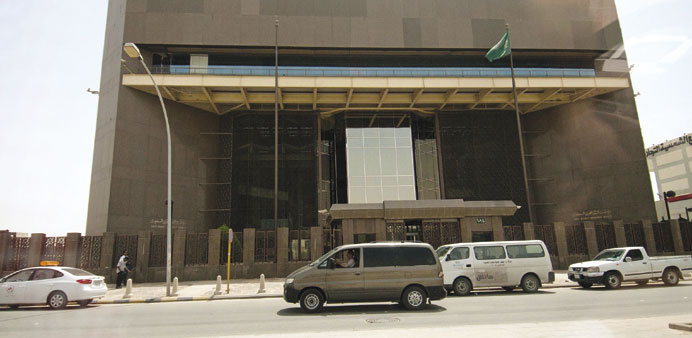Saudi Arabian bank deposits rose to the highest level on record in April to 1.3tn riyals ($350bn), central bank data show.
Bloomberg/Dubai
Saudi Arabian bank deposits rose to the highest level on record in April, helping to drive a benchmark used by lenders to price loans to the least in seven months.
Total deposits at lenders in the kingdom jumped 15% to 1.3tn riyals ($350bn), central bank data show. The three-month interbank offered rate, the benchmark for lending among Saudi banks, fell to a seven-month low earlier this month.
“There is a lot of liquidity out there across the entire balance sheet of Saudi banks,” John Sfakianakis, chief investment strategist at Masic, a Riyadh-based investment company, said in a phone interview. “The macro indicators are pointing to a robust economic growth story this year. The fact that we have additional liquidity should push interbank rates lower.”
The banks are benefiting from King Abdullah’s push to build roads, ports and industrial cities, as the Al Saud ruling family seeks to increase employment and salaries after protests toppled leaders across the Middle East.
Saudi Arabia has announced a $500bn plan for infrastructure and welfare. This year’s spending target is a record 820bn riyals, according to the 2013 budget.
Before the latest spending kicked in, the interbank rate was rising. It climbed 22 basis points in 2012, the most since 2005, to 0.995%. The rate was 0.965% on Tuesday, and fell as low as 0.9625% on May 13.
The lower rate reflects “sufficient liquidity in the system,” Murad Ansari, an analyst at EFG-Hermes Saudi Arabia, said in a phone interview. “Banks aren’t finding it difficult to raise liquidity through their deposits, and aren’t willing to pay more to borrow from the interbank market.”
Demand deposits, which pay no interest, rose 20% from a year earlier to 821bn riyals in April, central bank data show. Bank lending to the private sector rose 16%. That compares with March increases of 4.8% in the United Arab Emirates and 5.2% in Kuwait.
The kingdom’s $657bn economy grew 6.8% last year, according to the International Monetary Fund. It will expand 4.4% this year as the government pursues further infrastructure investments, the IMF said on May 20.
The kingdom has also cracked down on illegal workers in the country as part of an effort to create more jobs for its citizens and stave off unrest.
In Riyadh, new shops, restaurants and retail stores are opening as Saudis spend more from the “wealth effect” of increased salaries and more nationals entering the workforce, Sfakianakis said. “Consumer spending is truly expanding.”
Herfy Food Services Co, a fast food chain, is forecast to increase annual profit by 15% this year, according to a Bloomberg survey of analysts. United Electronics Co, which sells home appliances, is predicted to post a 17% gain.
Saudi companies are also benefiting from the cash flowing through the economy by getting lower pricing on Islamic sukuk and loans. Saudi Electricity Co, rated the fifth-highest investment grade of A1 at Moody’s Investors Service’s, paid 18% less in March than it did 12 months earlier to sell $1bn of 10-year sukuk.
Jadwa Investment Co, a Riyadh-based investment bank, said that it forecast annual credit growth of 16% to the private sector this year, with net credit issuance of 144bn riyals. “Expansionary government fiscal policy is expected to be the main growth driver,” it said.
While government spending is expanding credit and deposits, personal savings aren’t following, Asim Bukhtiar, head of research at Riyad Capital, said in a phone interview.
“Demand deposits as a proportion of total deposits are at abnormal levels,” he said. “There aren’t a lot of savings because rates are so low, especially on the consumer side.”
Since 2009, the bank has held its repurchase rate at 2%, the lowest since 2004, and the reverse repurchase rate at 0.25%. The Saudi riyal is pegged to the dollar and central bank policy often tracks the US Federal Reserve.
The easing on money markets isn’t boosting trade volumes on the Saudi stock exchange, with investors taking a “wait-and-see approach” to equities, Sfakianakis said.
The main index on the region’s largest bourse has advanced 8.3% this year. That compares with a 43% gain in Dubai and 33% in Abu Dhabi.
Global investment banks are expanding their presence in Saudi Arabia as investors seek greater access to the biggest Arab economy. In May, market regulators set a 10% limit for stock moves on the first day of trading for newly listed companies and imposed trading restrictions for listed companies with losses at or exceeding 50% of its capital.
“These changes are part of the steps to open the market to foreign investors,” Sfakianakis said. “The problem? The stock market isn’t the recipient of this liquidity in a sustained manner yet.”

